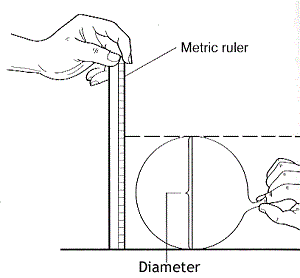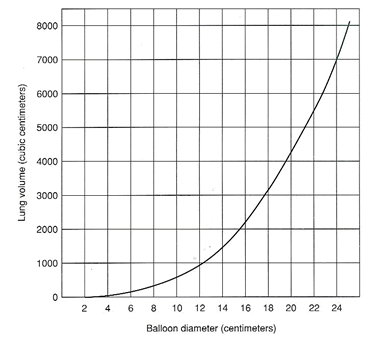Investigation: What Factors Affect Lung Capacity
The amount of air that you move in and out of your lungs while breathing normally is called TIDAL VOLUME. This amount of air provides enough oxygen for a person who is resting.
It is possible to inhale and exhale more forcefully - the maximum amount of air moved in and out of the lungs is called the VITAL CAPACITY, which is the amount of air a person can expel from the lungs at maximum inhalation.

Materials -- Balloons, metric ruler, meter stick (or rulers or tape measures)
Prediction: Which factor(s) have the most affect a person’s vital capacity? Rank in order from MOST effect (1) to least effect (5)
 The weight of the person
The weight of the person  The height of the person
The height of the person
 The sex of the person
The sex of the person  The age of the person
The age of the person  Activity level
Activity level
PROCEDURE
In this activity, you will be measuring the vital capacity of members of the class. If you have any breathing difficulties (asthma or other condition), you should not participate. You will be using the diameter of a balloon and the graph shown to estimate your capacities.

1. Choose 3 subjects from your group and record data on their height, age, sex, and activity level.
2. Measuring Vital Capacity -- Stretch a round balloon several times to stretch it out. Take a deep breath and then exhale into the balloon. Pinch the end of the balloon and measure its diameter in cm. Record on data table.
3. Convert the diameter to volume using the graph and record this on your table.
4. Estimated Vital Capacity
Research has shown that the capacity of a person's lungs is proportional to the surface area of his body and his height. This online calculator will use your height and age to estimate your vital capacity. Have each of your subjects record their data.
Go to this site: http://biol.co/vitcap1 and input information on test subjects. It will calculate the vital capacity.
DATA TABLE
|
Subject Data
|
Vital
Capacity
|
||||||
| Sex | Height | Age | Activity Level (low,medium, high) | Balloon Diameter | Volume (from graph) | Volume (from calculator) | |
|
Subject 1
|
|||||||
|
Subject 2
|
|||||||
|
Subject 3
|
|||||||
Subject 4 |
|||||||
ANALYSIS
1. What is the difference between tidal volume and vital capacity? Suggest a way you could measure a person’s tidal volume.
2. Compare your subjects’ vital capacity and variables listed (height, weight, sex..etc). Based on your limited data, which factors had the GREATEST impact on tidal volume.
3. What variables of your test subjects were necessary to input into the calculator? Which variables seem to have the LEAST effect on a person’s vital capacity?
4. How might an athlete's vital capacity compare to a non-athlete? Explain your reasoning.
5. Do you think the person with the greatest vital capacity can hold their breath longer than those with a lower vital capacity? Consider the difference between internal respiration and external respiration and explain why lung capacity may not have a great effect on length of time you can hold your breath.

